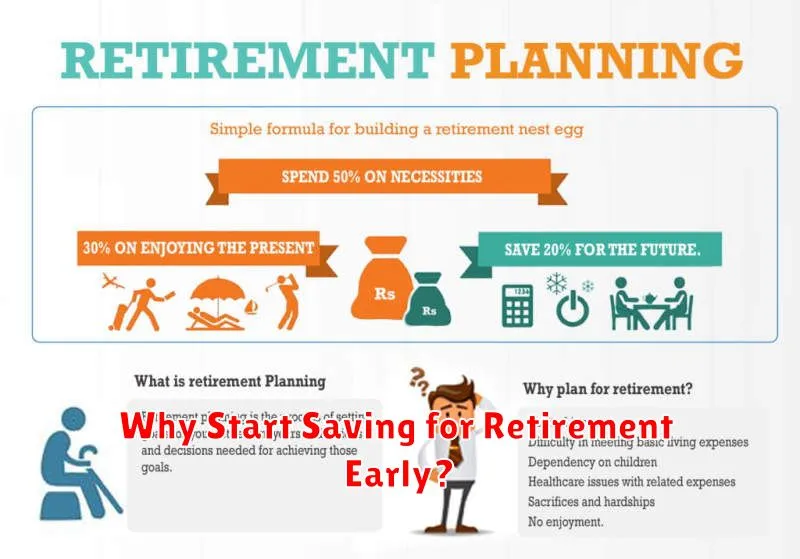Planning for retirement can feel daunting, but with the right knowledge and strategy, securing a comfortable future is achievable. This ultimate guide to retirement savings will equip you with the essential tools and information to navigate the complexities of retirement planning, covering topics such as retirement accounts (401k, IRA, etc.), investment strategies, pension plans, and withdrawal strategies. Learn how to maximize your savings, minimize taxes, and build a secure financial future for your retirement years. Discover the steps to create a personalized retirement plan tailored to your specific needs and goals.
Why Start Saving for Retirement Early?

Starting your retirement savings early offers significant advantages due to the power of compound interest. The earlier you begin, the more time your money has to grow exponentially.
Time is your greatest asset. Even small, regular contributions made early can accumulate into a substantial nest egg over several decades, thanks to the compounding effect.
Early saving allows for greater flexibility. You’ll have more options later in life, whether it’s retiring earlier, funding a more comfortable retirement, or simply having financial peace of mind.
Lower contribution amounts are needed early on to reach your retirement goals compared to waiting. This means less financial burden in the long run.
Finally, starting early mitigates the impact of unexpected life events, giving you a buffer to weather financial storms without jeopardizing your retirement plans.
Best Retirement Accounts to Consider

Planning for retirement requires careful consideration of various savings vehicles. Choosing the right account depends on individual circumstances, such as income, age, and risk tolerance. Several options stand out as particularly beneficial.
401(k)s are employer-sponsored retirement plans offering tax advantages. Contributions are often tax-deductible, and earnings grow tax-deferred. Many employers offer matching contributions, essentially free money towards retirement.
Traditional IRAs provide tax-deductible contributions, with earnings taxed upon withdrawal in retirement. They’re suitable for those who expect to be in a lower tax bracket during retirement than they are currently.
Roth IRAs offer tax-free withdrawals in retirement. Contributions are not tax-deductible, but qualified distributions are tax-free, making them attractive for those who anticipate being in a higher tax bracket during retirement.
Roth 401(k)s combine the benefits of a 401(k) with Roth IRA features. Contributions are made after tax, but withdrawals in retirement are tax-free.
SEP IRAs are designed for self-employed individuals and small business owners. They allow for higher contribution limits than traditional IRAs, offering significant tax advantages.
The best retirement account for you will depend on your specific financial situation and retirement goals. Consulting with a financial advisor can help you determine the most suitable option to achieve a comfortable retirement.
How to Calculate Your Retirement Needs
Accurately estimating your retirement needs is crucial for planning a comfortable future. A common method involves the 80% rule, suggesting you’ll need 80% of your pre-retirement income to maintain your lifestyle. However, this is a broad guideline and individual needs vary.
To refine your calculation, consider your desired lifestyle. Will you travel extensively, pursue hobbies, or maintain a similar living standard? List your anticipated expenses, including housing, healthcare, transportation, food, and entertainment. Project these costs into the future, accounting for potential inflation using an inflation calculator.
Next, factor in your current savings and investments. Assess the potential growth of your assets based on conservative estimates. Account for any additional income streams in retirement, such as Social Security or pensions.
Finally, compare your projected retirement expenses with your estimated income sources. The difference represents the retirement savings gap. This figure will guide your savings plan, illustrating how much you need to save annually or adjust your spending projections.
Remember, this is an estimation. Regularly review and adjust your calculations as circumstances change. Consulting a financial advisor can provide personalized guidance and help refine your retirement planning strategy.
Investment Options for Retirement

Choosing the right investment options for retirement is crucial for securing a comfortable future. Your choices should align with your risk tolerance, time horizon, and financial goals.
Stocks offer the potential for high returns but also carry higher risk. Bonds are generally less risky and provide more stability, although returns are typically lower. A well-diversified portfolio often includes a mix of both.
Mutual funds and exchange-traded funds (ETFs) provide diversification by investing in a basket of stocks or bonds. They are convenient and offer professional management, but come with fees.
Real estate can be a valuable long-term investment, offering potential for appreciation and rental income. However, it requires significant capital and management.
Annuities provide a guaranteed income stream in retirement, but returns may be lower than other investments. Retirement accounts like 401(k)s and IRAs offer tax advantages and can be invested in various options.
It’s essential to consult with a financial advisor to determine the best investment strategy tailored to your individual circumstances. Careful planning and diversification are key to building a successful retirement portfolio.
Understanding Social Security Benefits
Social Security is a crucial component of retirement planning in the United States. It provides a safety net for retirees, offering monthly payments based on your earning history.
Eligibility is determined by your work history and the amount of Social Security taxes you’ve paid. The amount you receive in benefits is calculated using your highest 35 years of earnings, adjusted for inflation.
Full retirement age (FRA) is the age at which you are entitled to receive your full Social Security retirement benefit. This age varies depending on your birth year. You can claim benefits earlier than your FRA, but your monthly payments will be permanently reduced. Conversely, delaying benefits past your FRA will result in higher monthly payments.
Beyond retirement benefits, Social Security also offers disability benefits and survivor benefits for spouses and children of deceased workers. Understanding these different benefit types is crucial for comprehensive retirement planning.
It is highly recommended to consult the Social Security Administration’s website or a financial advisor for personalized information about your specific eligibility and benefit estimations.
Tax Benefits of Retirement Savings
One of the most significant advantages of contributing to retirement savings plans is the tax advantages they offer. These benefits can significantly reduce your current tax burden and boost your overall retirement savings.
Many retirement accounts, such as Traditional 401(k)s and Traditional IRAs, allow for pre-tax contributions. This means your contributions are deducted from your taxable income before taxes are calculated, resulting in lower current year taxes. However, remember that withdrawals in retirement are taxed as ordinary income.
Alternatively, Roth 401(k)s and Roth IRAs offer tax-free growth and withdrawals in retirement. While contributions are made after tax, qualified withdrawals are not taxed, providing significant long-term benefits. The choice between traditional and Roth accounts depends on your individual circumstances and anticipated tax bracket in retirement.
Beyond specific account types, many retirement savings plans offer additional tax benefits such as tax deductions for contributions (depending on income limits and eligibility), and in some cases, tax credits for those with lower incomes, further encouraging retirement savings.
It’s crucial to consult with a qualified financial advisor to determine which retirement savings plan and tax strategies best suit your individual financial goals and tax situation to maximize your benefits.
How to Adjust Savings Over Time
As your income and life circumstances change, so too should your retirement savings strategy. Regularly reviewing and adjusting your savings plan is crucial for ensuring you stay on track to meet your retirement goals.
Increased income allows for increased contributions. Consider boosting your contributions to retirement accounts proportionally to any salary raises or bonuses. This takes advantage of compounding interest and accelerates your savings growth.
Life events, such as marriage, children, or homeownership, may necessitate adjustments. You might need to temporarily decrease contributions to address immediate financial needs, but aim to resume or increase contributions as soon as feasible. Prioritize maintaining a consistent savings habit even if the amount fluctuates.
Market fluctuations require adapting your investment strategy. Diversification across different asset classes mitigates risk. Regularly rebalance your portfolio to maintain your desired asset allocation, ensuring you don’t become overly concentrated in any single area. Seek professional financial advice if needed to guide you through market volatility.
Unexpected expenses can disrupt savings plans. Create an emergency fund to cushion against unforeseen events. This fund allows you to handle unexpected costs without depleting your retirement savings. Regularly evaluate your emergency fund and adjust as needed based on your changing needs and financial stability.
Retirement planning is a dynamic process, not a static one. By actively monitoring your savings, adapting to life changes, and seeking professional guidance when necessary, you can significantly enhance your chances of achieving a comfortable retirement.
Common Mistakes in Retirement Planning

One of the most prevalent errors is underestimating expenses. Many retirees fail to accurately account for healthcare costs, inflation, and unexpected expenses, leading to insufficient savings.
Delaying retirement savings is another significant mistake. The power of compounding returns diminishes when starting late, making it harder to accumulate the necessary funds. Starting early, even with small contributions, significantly impacts long-term growth.
Ignoring inflation is a crucial oversight. Inflation erodes the purchasing power of savings over time. Failing to account for inflation’s impact on future expenses can lead to a significant shortfall in retirement income.
Lack of diversification in investment portfolios exposes retirees to unnecessary risk. Over-reliance on a single asset class can result in substantial losses if that asset performs poorly. A well-diversified portfolio mitigates this risk.
Not having a written plan is a common mistake. A comprehensive retirement plan outlines financial goals, savings strategies, and risk tolerance, providing a roadmap for a secure retirement. Without a plan, it’s easy to stray from financial objectives.
Finally, failing to adjust the plan regularly is a critical error. Life circumstances change, and so should your retirement plan. Regularly reviewing and adjusting your plan based on your changing needs and financial circumstances ensures it remains relevant and effective.

